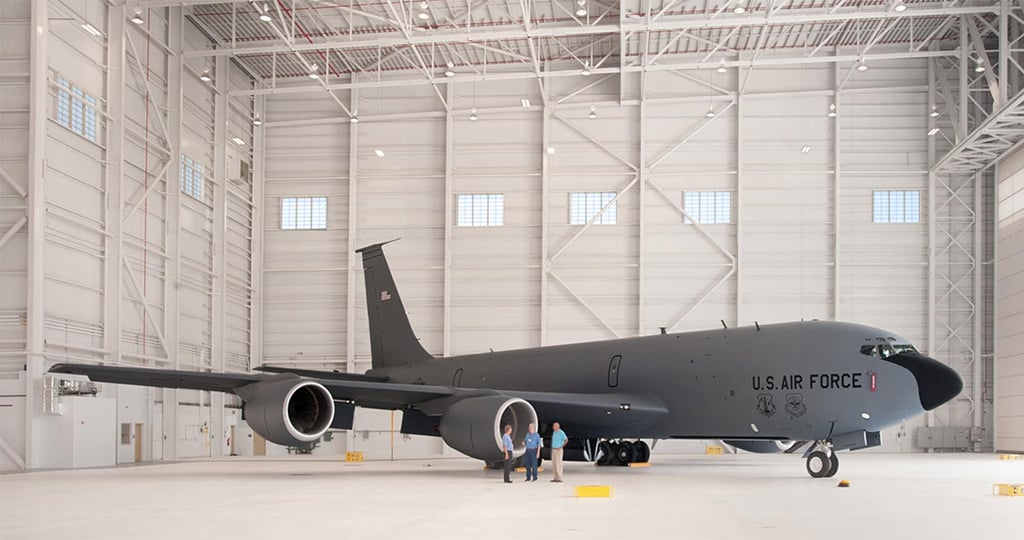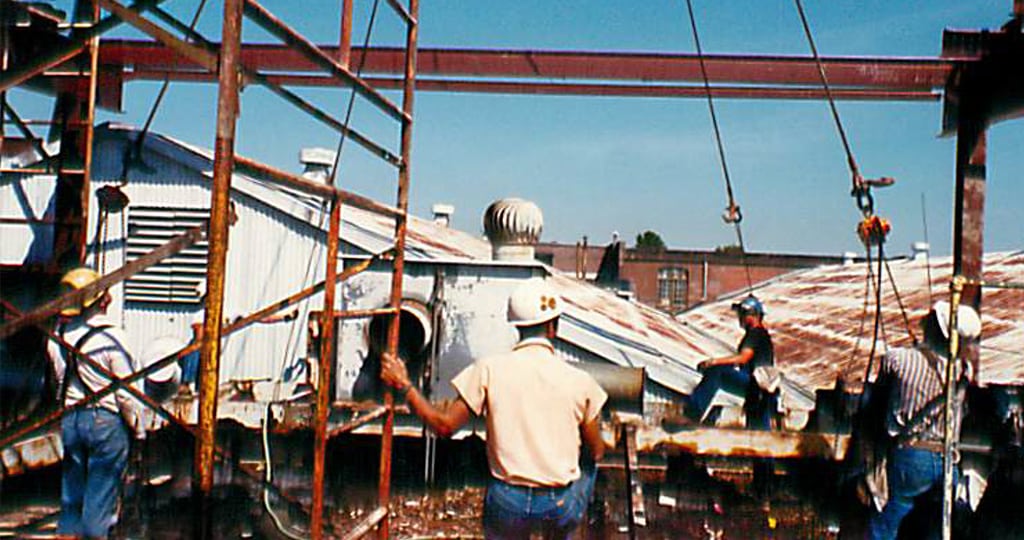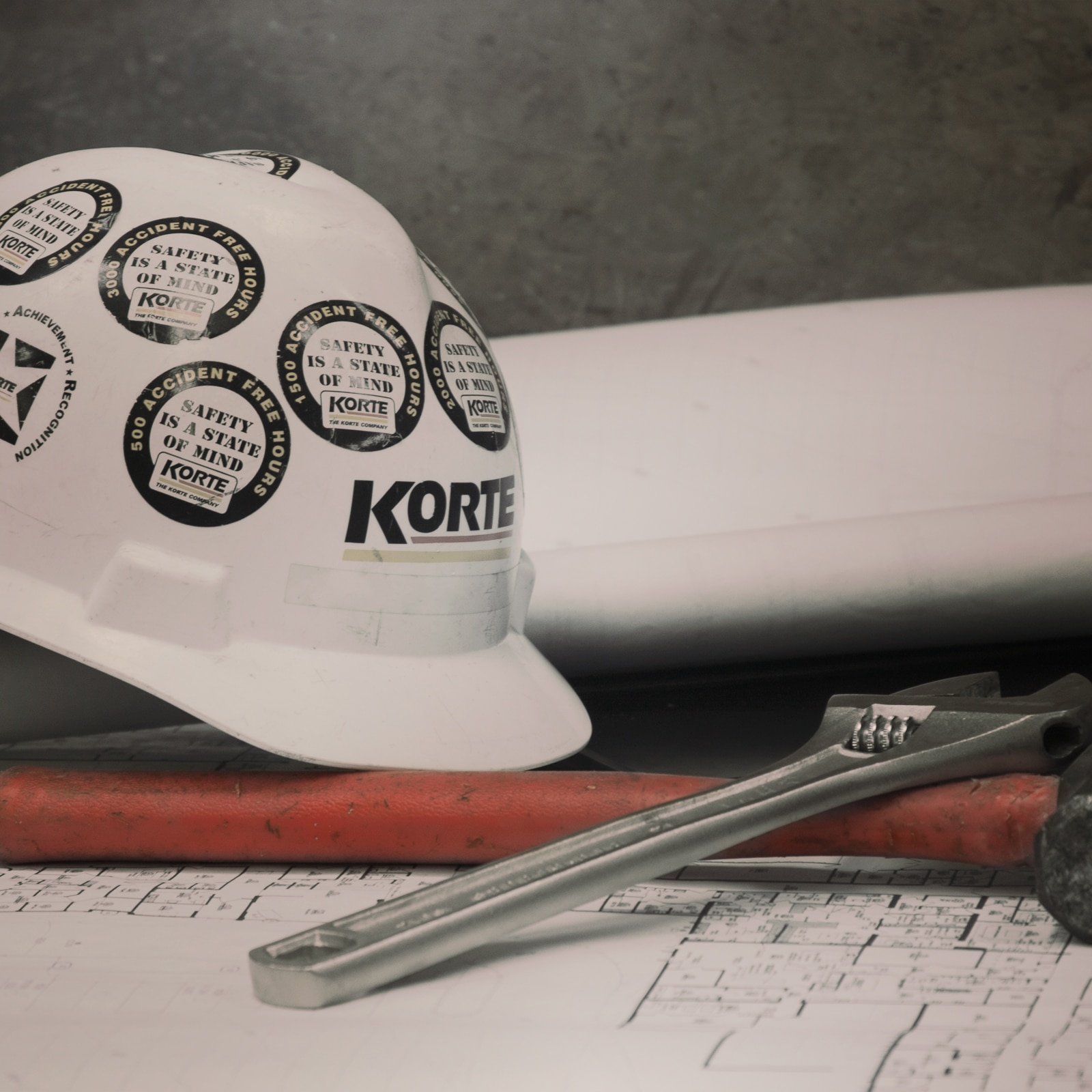Jerry Rehkemper felt very small, and that made him rather proud.
The 164,000-square-foot airplane hangar doorway that he had helped build towered above his head. The door was so big that three 80-foot-tall structural bridges were used to lift its header into place in four pieces.
Standing before a massive airplane hangar in Tinker Air Force Base, he knew Grandpa would’ve been proud of this one.

Grandpa Ben passed away when Jerry was 10 years old, but they had enough time together for Jerry to absorb a lifetime passion for construction from the man whose name folks still remember as a quality builder.
“We designed it, we built it, and had a happy owner, and the job got done on time, and we made money,” Jerry said. “It was a great feeling.”
Jerry carried on his grandfather’s legacy in a big way, leading The Korte Company’s preconstruction department through some of the most important projects in the company’s history. He retired from the company as a senior vice president in 2012 and remains a trusted estimate advisor. He still lives in Highland, Illinois.
But it was a long road to the executive board room. It took plenty of happy accidents and leaps of faith to get him to the top of his career ladder.
Finding his footing
As the middle child in a brood of seven, Jerry learned the value of hard work from a young age. He took a job as a farmhand when he was still in the eighth grade.
His parents drove buses in the mornings. His father also ran a small trucking business during the day, while his mother worked as a school cook before climbing back into the bus to take the kids home again.
Grandpa Rehkemper lived with the family throughout Jerry’s life. He owned Rehkemper Construction, which one of Jerry’s uncles eventually took over and is now a five-generation family business.
While Jerry always looked up to his grandfather, it took a guidance counselor at Mater Dei Catholic High School to set him in Grandpa’s footsteps.
As a senior in high school, Jerry didn’t know what he would do with his life. The counselor sat him down to learn about the young man’s interests. Driving a school bus was ruled out, but he was intrigued by the idea of going into construction like his grandfather. Nobody in his family had gone to college, and Jerry didn’t think his grades were good enough to break the pattern. He would only agree to a nearby college. The counselor found a two-year construction program at SIU Carbondale’s technical school, and Jerry enrolled.
Despite his apprehensions, he excelled in his construction classes and felt that he had found his calling.
Summers were spent working for Rehkemper Construction, which had become a well-known residential builder in the area. It just so happened that the company built a house for the Korte family, which came in handy after Jerry graduated in 1976 and started applying for jobs.
A long walk
Larry Korte, the General Superintendent for what was then known as Ralph Korte Construction, recognized the Rehkemper name on Jerry’s job application and called him in for an interview. Within five minutes, Jerry was hired as a surveyor’s assistant.
It didn’t last long. He was laid off from the surveyor team after only about two weeks because there wasn’t enough work available. But it only took another week for Jerry to get back on the company payroll.
Jerry told Larry Korte that he was willing to do anything to return to the industry and accepted a position in the warehouse. He spent two and a half months stenciling ‘RKC’ on tools and gas cans.
Though appreciative of the work, Jerry couldn’t help feeling under-utilized in the warehouse. Humble as ever, it took several starts and stops before he got up the courage to ask Ralph Korte for a promotion.
“It was a 50- or 60-step walk up to Ralph’s office,” Jerry said. “I’m a young kid, and I didn’t have a lot of guts, so the first week, I made it halfway up the hallway, and turned around, and then a week or two later… I made it three-quarters of the way up there, and turned around, and then on the third try, I made it all the way to his office.”
His initiative paid off, and by Monday morning, Jerry was an assistant superintendent on a 24-unit apartment project in Breese, Illinois.
Ralph created the new position for Jerry to get him out of the warehouse, so it wasn’t as demanding as Jerry would’ve liked, but he’d proven himself willing to take up new challenges, so Ralph transferred him that November to help out in the estimating department, where Jerry finally found his place.
The buildup
Despite his hectic advance, Jerry learned more in this first year with the company than he had in two years at college, working on jobs like an addition at the St. Clair Square mall in Fairview Heights, Illinois.
His duties included providing material prices and coordination with subcontractors.
Vern Eardley noticed the young man’s work ethic by 1978. Vern wondered whether Jerry was interested in taking over as head estimator in the company’s Marion, Illinois office and offered him the position on a Friday. By Monday, Jerry had moved to Marion and was on the job.
“I had never bid a job by myself,” Jerry said. “So they kind of threw me into the fire.”
Estimators play a pivotal role in the success of any construction project. They collect and analyze all available information about the project’s specifications, location and many other factors to estimate the time, materials, labor and expenses necessary to complete a contract. In Design-Build projects, they work closely with architects to keep projects on schedule and under budget.
Jerry fought through the flames and came out the other side as an accomplished estimator with five years of bidding on jobs from the Marion office.
One of his first major projects was a 7,500-square-foot Lake of Egypt house for the owner of the Marion Pepsi-Cola Company, which he bid on with the help of Head Estimator Cornell Meyer. The bid came in so cheap that Vern thought the estimators had made a miscalculation. He called them back from the golf course to check the numbers again, but upon further review, everything was just right.
“We went back into the office, and we went through all of the estimates and told them we didn’t make any mistake,” Jerry said. “We bid it tight, and I was the project manager on it, and we made some money after the job was done.”
This early job taught Jerry the value of knowing the exact specifications for every project, because every detail matters. This bit of wisdom became a recurring theme in Jerry’s career and a lesson that he would pass on to the next generation of estimators.
“You’ve got to know the job, and so that was always a pet peeve of mine—don’t ever miss anything on the plans and specifications,” he said.
It was during this time that Jerry felt inspired to continue his education, following the example of Ralph Korte, who attended night school for 10 years as he built the foundations of his construction company. Jerry returned to SIU Carbondale for five years of night classes before earning his bachelor’s degree in construction management.
“I don’t think I would’ve gone on [in my education if Ralph] hadn’t done what he did, going the 10 years in night school,” Jerry said.
The comeback
Jerry worked in Marion until he suffered a severe concussion in a bad car accident in 1983. He moved back to Highland to recover and worked as a purchasing agent for the next year, writing subcontracts and purchase orders.
It didn’t take long for Jerry to again feel like he was being under-utilized, especially when he started noticing inflated estimates coming across his desk.
He addressed the issues with Vern, who decided that if he was going to be monitoring the work, he might as well take over the Highland estimating department. Looking back on it, Jerry considers earning his first major leadership position to be one of the proudest moments of his career.
“I think that was the clear highlight,” he said. “They knew I had the tools to do that work.”
Jerry took on this new responsibility during a time of intense company growth. Projects were getting bigger and more complicated—from $5 million to $15 million—so Jerry had to be one step ahead of everyone else, estimating how much each project would cost and how they could best meet the customer’s specifications.
Jerry worked directly under Vern, who reviewed every estimate before the job began. Vern instilled some principles in honesty that Jerry carried for the rest of his career.
“He always said, ‘Jerry, bid them what they will cost, not what they should cost.’ So I always remembered that when I put an estimate together,” Jerry said.
Jerry worked hard to meet the challenges of his new responsibilities, helping other departments with major projects while leading his own team of up to a dozen people, even over the Labor Day weekend if necessary.
Jerry was promoted to vice president after three years as a head estimator. He said the title didn’t mean nearly as much to him as doing good work for customers. And yet, he kept serving customers so well that about 10 years later he was promoted to senior vice president in the mid-90s.
During this time, The Korte Company brought on some of its biggest clients, like Walgreens, Hershey and General Tire, which required Jerry to do tons of traveling. By his count, he worked on roughly 200 major projects in 30 states over the course of his 35-year career. Every new environment created new challenges for the preconstruction department, from sandy Hawaiian beaches to the harsh Alaskan cold.
Jerry has watched The Korte Company grow from delivering about $8 million in business when he started to as much as $300 million late in his career.
The preconstruction practice also progressed throughout Jerry’s career, from estimating by hand, flipping through plans on stacks of paper, to laying out entire projects through computer modeling.
While Jerry used to pore through design drawings with a handful of colored pencils, computer-aided design programs can automatically synthesize tons of data with pinpoint accuracy.
The advantages of high-speed computer planning are undeniable, but Jerry still misses the feeling of holding paper building plans in his hands. He wasn’t completely convinced by the new technology until around 1986, when the computer proved more accurate at adding up estimated figures than his long-time secretary.
Most of his major projects were Design-Build, requiring close coordination with architects. This was especially true when it came to working with the Department of Defense.
“You’re working with the Corps of Engineers and they give you a three-and-a-half-inch-thick specification to look at, and they knew that specification inside and out, and you really had to look at the plans and the specifications ultra-carefully to bid these jobs, because if it said it in there, they’re going to demand it,” Jerry said.
This was when Jerry found himself standing before that massive airplane hangar in Oklahoma, thinking about how far he’d come since he started in construction. The company has come a long way as well, contracting for two more projects on the base and working on several other airplane hangars for the Navy, Customs and Border Protection and private companies.
While helping to build the hangar Tinker Air Force Base was a proud achievement, Jerry said his favorite project was completed in 1987 at Jefferson Smurfit, a packaging corporation back in Highland.

Factory managers were complaining that the building was too flimsy and feared it would cave in after a heavy snowfall. His team was tasked with building a new facility over an ongoing cardboard production operation. They had to erect a metal building around the existing wooden structure before taking the old building down from the inside. The task was so challenging that nobody else would bid on the job.
The process required some of the most creative preconstruction planning of Jerry’s career. The crew poured the foundations, slabs and footing all without interrupting the manufacturing line. They then cut holes in the existing roof and set columns through the openings before putting the metal building together.
“That was very unique,” Jerry said. “I’ve never heard of another company ever doing that.”
Leaving a legacy
While Jerry feels very fortunate for everything he has experienced and all the opportunities he’s been given in his career, he also faced many personal challenges throughout his life.
His first wife, Geralyn, died of breast cancer in 1997, leaving Jerry to care for their three young children. Jerry’s priorities shifted, going from working 60 hours a week to a mere 40 to 50. Five years went by before he met his second wife, Paula, and added two step-children to his family. The family has since grown even more with the addition of three grandchildren.
By 2011, Jerry was feeling his years.
It’s stressful being a senior vice president, and he wanted to spend more time with his family.
He remembered Grandpa Rehkemper. He was a grandpa now, too. It was time to retire.
But Jerry still enjoys returning to the office every now and again to offer advice or borrow some tools out of the warehouse.
“If they need my help, I help them out, because they’re the reason I’m retired, and they were such a good company,” he said. “And they have this wonderful policy of only Korte retirees can borrow any tools they want, and that’s such a nice feature to do home projects.”
While Jerry occasionally borrows tools, he has left behind a permanent legacy at the company.
Several of the people Jerry taught at The Korte Company have gone on to lead their own departments at other firms, knowing Jerry taught them the right way to do the job.
He always hammered home that you can never leave anything out of an estimate, whether it costs $5 or $5,000.
“They all say I taught them the right way to do it,” Jerry said. “I like to hear that.”
These days, Jerry’s at peace in retirement. He exercises daily. He attends mass at St. Paul in Highland. He’s seen the world—Ghana, The Holy Land, Ireland.
Ireland is his favorite.
“I love the pubs. They’ve got 750 pubs in Dublin,” Jerry said. “It’s just like the pictures they show you in the magazines, that’s exactly how Ireland looks.”
